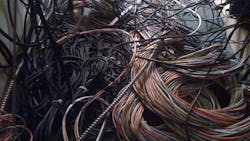Can audiophiles and causal listeners improve their stereo system by upgrading one of the seemingly simpler components, the speaker wires and connectors? Some companies insist they can. So they offer speaker wire (or cables), sometimes for thousands of dollars that promise better tonality, warmer sound, and richly melodic sound free of grain. But many of these claims are bogus and they create myths surrounding speaker wires. Here are five of them:
Thicker wires are better: It’s true that for long runs, thicker wires are better at reducing the effects of resistance. But for most set ups (those with speakers within 100 ft of the amplifier), 16-gauge lamp cord is fine. For speakers 100 to 200 ft. from the amp, experts suggest use 14 gauge. And from 200 to 400 ft., they recommend 12-gauge wires. Using extremely thick wire for short runs yields virtually no audible benefit, at least none most people can hear.
Solving skin effect: It’s true that higher frequency signals tend to travel on a wire’s perimeter while lower-frequencies signals travel near the center. But any effect is only noticeable when dealing with miles of cable and frequencies not used for audio. So don’t waste any money “solving” this problem with intricately braided speaker cables.
Speaker wires should be the same length: It seems to make sense that speaker wires should be identical to eliminate phase shifts. But electrical signals travel through speaker wire at near the speed of light. It would take miles of speaker wire to hear any difference. So having wires a foot or two (or 10) different is irrelevant.
Break-in is “critical”: According to some so-called audio experts, the small electrical current passing through speaker wire physically alters the wire enough to create an audible change over time. Not true. Still, companies try to sell wire "cookers" and break-in services to perpetuate this myth and make a buck.
Splices degrade the sound: Audio experts have determined that properly spliced and soldered wires do not change or degrade the sound coming out of speakers. Although an oscilloscope can detect splices by identifying small voltage drops or spikes, the anomalies are too small to hear. Voltage used for driving speakers is simple voltage, and since regular fluctuations due to program and frequency type occur during normal use, splices produce no adverse audible effect.
Have you heard any stereo myths you’d like to pass on? Now’s the time.

